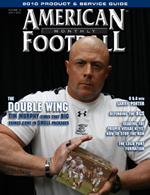AMERICAN FOOTBALL MONTHLY THE #1 RESOURCE FOR FOOTBALL COACHES
Article CategoriesAFM Magazine
|
Developing an Off-Season Competition Program (Part II)by: Tad DePorterOffensive and Defensive Line Coach and Co-Defensive Coordinator, Richmond-Burton High School (IL) © More from this issue Last month Coach DePorter outlined the reasons for installing an ‘Off-Season Competition Program’ at Richmond-Burton High School. The program places all players onto teams, holds them accountable in a number of areas, and awards points in all phases of competition. In this issue, Coach DePorter discusses competition in other sports, community service, scoring and organization of the competition, rewards, and results. Other Sports Roughly 65% of our players are multi-sport athletes. We, as a staff, encourage this and prefer our athletes participate in multiple sports. It gets our players competing all year long, which is crucial to creating a successful program. It also improves their skills and abilities that can carry over from participation in other sports (e.g., leverage in wrestling, footwork in basketball, etc.). In terms of scoring points, players who participate in other sports earn ten points per week for the duration of the season. This starts in January and continues through the end of the spring sports season for all players at all levels. The only differentiation that exists is the length of the varsity season compared to the freshmen and sophomore seasons. We have also allowed players to score points for being involved in other school activities, such as the Academic Team, but we have handled those on a case-bycase basis and still have those athletes come in and be a part of the competition. Community Service Many coaches pay lip service to community service, but it is something that our program requires. Our players are required to participate in two hours of community service which earns them ten points for their team (five points per hour). Any community service hours must be pre-approved by a coach (there is a form they are required to fi ll out) and the individual team is encouraged to do these hours together but it is not required. However, it is required that all members of the team have two hours of community service in order to be eligible for the rewards, which will be described later. We also require that a supervising adult sign off on the hours completed (this is part of the form they are required to turn in). This is the only category of points that is unlimited. This encourages our players to involve themselves in as much community service as possible. Scoring & Organization Every two weeks I tally up the points and rank the teams. The ranking is based on the average number of points each player has earned for their team which takes care of any differences in the number of players on each team. Each team has an Excel spreadsheet that organizes the points into each category and it is set up to be updated anytime I put points into any category. The sheet also fi gures the average number of points which is the basis for the bi-weekly rankings. Team rankings are posted outside my classroom and in the weight room. Anytime the standings are posted, a copy of the individual team point breakdown is sent to the captain. Rewards We stress the individual rewards the players will receive by being a part of this program such as increased strength, speed and agility, improved academic standing, etc., but we also provide our athletes with tangible recognition of their commitment to the football program as well. Teams can earn shirts, shorts, polos, steak dinners, and more by achieving the point standards that were established. For example, by earning 2000 points as a team, players would earn a Richmond-Burton strength and conditioning shirt and a pair of shorts. For each level of points, the rewards increase, but we have tried to make the standards challenging yet achievable. Results So far, this program has been successful for our players. We now average 20 – 25 players in the weight room, which, when you consider the number of two and three-sport athletes, we have accounted for 95% of our players. What we believe is the most important benefi t is the camaraderie that has developed among our players. Our freshmen now have become important to our juniors. I have heard conversations between juniors and freshmen talking about how a test went or convincing the freshman to go out for track. Those are conversations that never took place before. It clearly has been a worthwhile program for our athletes. About the Author: Tad DePorter has been coaching at Richmond- Burton High School for three years as the offensive and defensive line coach as well as codefensive coordinator. He previously coached at Sherrard High School (IL) for three years. DePorter’s teams have qualifi ed for the state playoffs five times in his six years as a coach. |
|
| HOME |
MAGAZINE |
SUBSCRIBE | ONLINE COLUMNISTS | COACHING VIDEOS |
Copyright 2024, AmericanFootballMonthly.com
All Rights Reserved




